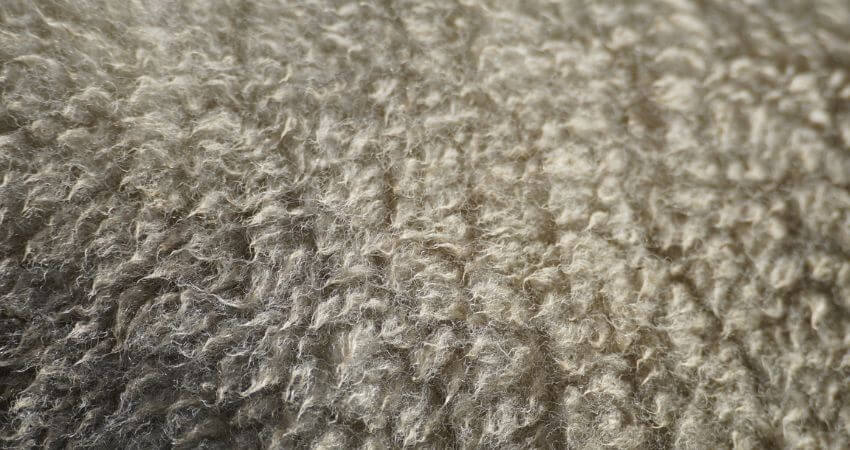If you buy via any of our links, there will be no additional cost to you, and we will receive a tiny commission. More information is available on our Affiliate Disclosure page.

What is Fleece Made Of?
What is Fleece Made Of? Fleece is made of synthetic materials like polyester. It’s a soft and warm fabric, perfect for cozy jackets, blankets, and winter wear.
It is a surprising material that can keep you warm and cozy on even the coldest days, but fleece is made up of what material?
And
What is fleece made of?
The first polar fleece, a synthetic replica of sheep’s wool, was developed in Massachusetts in 1981. Like the material polyester, it is one of a select group of well-known speculate fabrics made from reclaimed plastic.

What is Fleece?
This is one of the softest and warmest fabrics. Many items of clothing are made out of it.
You will see that it is to make outdoor activity wear. It is easy to dry, very light in weight, warm, and protects against wind and rain.

Usually, it is from polyester or nylon. Synthetic fabric keeps you warm and breathable, and this is an excellent choice for colder conditions. You can brush it to give the garment a soft look, making it suitable for casual wear. The thicker the fabric, the warmer it will keep you.

This is great when it is cold outside. It works as a good insulator for clothing, allowing you to stay warm even in cooler temperatures.
What is Fleece Made of?
This is from natural fibers such as wool, mohair, alpaca, and silk. These are blended with synthetic fibers like acrylics and nylon to make a durable and functional fabric.
This is a fabric that feels nicely adjusted to your skin. It is used for outerwear like jackets and sweatshirts.
As we described, It is made out of polyester, a synthetic fiber that blends in polyethylene terephthalate (PET) and polybutylene terephthalate (PBT).

There are three different grades of fleece fabrics. They are nylon, microfiber, and acrylic. These are all made out of polyester. They vary in quality and price. Some of the best quality it is made from microfiber, it is lighter than nylon and acrylic. Microfiber is the softest and most comfortable fabric. It is best for kids’ clothing. Microfiber fleece is soft and can use next to the skin.
Polyester is a synthetic fiber that blends polyethylene terephthalate (PET) and polybutylene terephthalate (PBT), and it is used in three different grades of fleece fabrics: nylon, microfiber, and acrylic. These fabrics are all made out of polyester and they vary in quality and price. Microfiber fleece, which is the best quality and made from microfiber, is lighter than nylon and acrylic. It is the softest and most comfortable fabric, making it ideal for kids’ clothing. Microfiber fleece can be used next to the skin.

What is Fleece Used to Make?
This is a type of fabric made of synthetic fibers. They are into different materials such as jackets, sweaters, hoodies, shirts, pants, blankets, hats, socks, and gloves.
Fleece is a popular choice for both body and clothing due to its softness and warmth. It has been a staple in American homes for over 40 years and is known for its durability and flexibility, making it ideal for colder weather. Wearing fleece provides a cozy and comfortable sensation, keeping you warm during chilly seasons. Many individuals prefer fleece over synthetic fibers, as it offers breathability, and moisture-wicking properties, and ensures dryness and comfort throughout the day.
It is versatile because it is soft, warm, and comfortable. It is ideal for those who enjoy being outside. The fleece’s best feature is that it is lightweight and breathable.

Feather comes in two varieties. The name of one of them is “fleece.” It is a thin, soft fabric made by humans. Because of this, it serves a variety of functions. Clothing, bedding, and footwear are a few examples of other uses.
Fleece is a versatile fabric known for its softness, warmth, and comfort. It is highly preferred by individuals due to its breathability and moisture-wicking properties, ensuring a dry and comfortable experience. This lightweight and breathable material is ideal for outdoor activities. Fleece serves various purposes, including clothing, bedding, and even footwear.

“Wool fleece” is the name of the second kind of fleece. Both alpaca and wool are used to make it. Many blankets, jackets, coats, and other warm garments are made from this fleece.
It can be used for a variety of different items. For instance, there are bed sheets, blankets, comforters, and throws.
Where Does Fleece Come From?
When people talk about fleece, they usually think about the soft, cozy fabric that can be worn while going outside during the winter. But the material has much more history than that.
Fleece is a popular material for clothing due to its softness and warmth. It has been widely used in American households for over 40 years. Its supple and sturdy nature makes it perfect for the cold weather season, providing a warm and comfortable feeling. Many individuals prefer fleece over fabrics with synthetic fibers. This material is particularly beneficial for undergarments as it allows breathability, wicks away sweat, and ensures dryness and comfort.
Malden Mills teamed up with Patagonia in 1981 and released Synchilla. From then, it has become the standard for outdoor apparel companies.
It is especially light and quite soft. The fabric has a highly resistant capacity against water and wind, which makes it great for outdoor activities.

Even though the fleece can be used for a light outer layer, when combined with a heavier, warmer jacket can be better insulation.
Fleece is a popular fabric choice due to its softness and warmth. It has been widely used for over 40 years in American households. This material is known for its flexibility and durability, making it perfect for the cold weather season. Wearing fleece provides a comforting and cozy sensation. Many individuals prefer fleece over synthetic fiber fabrics for its breathability, moisture-wicking properties, and ability to keep them dry and comfortable.
Fleece isn’t just for outdoors, it’s also commonly found in sports clothes and bedding.
What are The Environmental Downsides? (What is Fleece Made Of)

When you wear clothing made out of synthetic materials like polyester, you will create an environmental impact. Polyester production needs a huge number of fossil fuels. For your information, it takes over 200 pounds of oil to make one pound of polyester.
The production of fleece requires an unbelievable amount of energy, and the process utilizes harmful chemicals, including carcinogens, which can wind up in the air and water. There are many carcinogens found in fleece. These chemicals include benzene, formaldehyde, and polybrominated diphenyl ethers (PBDEs).

Let’s examine the hazards that this poses to the environment.
Not all fleece uses recycled plastic; this fleece is created using virgin plastic. The non-renewable petroleum derivatives used to make recycled and non-recycled fleece are the same ones responsible for global warming.
Why is Fleece Popular?
It is soft, and warm, and can be used in cold weather. It is flexible, lightweight, breathable, and suitable for cold areas.
The thin fleece is light and durable and can use in warm weather too.

This is very useful for outdoor activities, especially in cold atmospheres.
This is easy to wash don’t need to worry like wool or silk. It is known in many parts of the world because of its advantages. You can use this fabric in the winter season. This is good for your body and clothing because it is soft and warm.

Conclusions
For more than 40 years, this material has been a standard in American homes. It is supple and sturdy, perfect for the cold weather season, and gives you a warm, comfortable feeling.
This material is commonly known as fleece, and it is made from synthetic fibers. It provides softness and warmth to your body and garments. Fleece has been a popular choice in American households for over 40 years. Its supple and sturdy nature makes it ideal for cold weather conditions, giving you a warm and comfortable feeling. Many people prefer fleece over fabrics with synthetic fibers because it has breathability and moisture-wicking properties, and keeps you dry and comfortable.
Many people prefer to wear it over other fabrics, especially those with synthetic fibers. This is very useful for the undergarment because it breathes, wicks sweat away and keeps you dry and comfortable.

